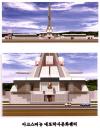Institute for Far Eastern Studies (IFES)
NK Brief No. 10-6-23-2
6/23/2010
Kim Jong Il visited Sinuiju on June 17, spending three days inspecting industrial facilities with third son and possible successor Kim Jong Eun. One visit was to a shoe factory, at which Kim Jong Il observed modernized technology and production equipment. On another stop, at the Sinuiju Cosmetics Factory, Kim Jong Il met with the factory manager and foremen, providing them and the laborers with encouragement. Kim Jong Eun also made an appearance at the meeting, indicating that the effort to install him as the next North Korean leader has progressed to the point at which he is being directly introduced to the people.
According to a Daily NK report quoting a source in Sinuiju, Kim Jong Il’s automobile procession to Sinuiju was “impressive”, and was “about twice as large” as previous processions. The report also noted that Kim Jong Eun exited a care and met directly with workers at the cosmetics factor and at Rakwon Machine Complex, and that “Kim Jong Eun took most of the responsibility for [Kim Jong Il’s] protection entourage and for the on-site guidance.”
That on-site guidance parties have grown considerably larger than in other years is partly due to the fact that Kim Jong Eun is accompanying his father, but also because many more other officials are also traveling with Kim Jong Il. On-site guidance has transformed from that of giving business advice to actively promoting succession by Kim Jong Eun. According to one source, Kim Jong Eun took the lead on everything from succession issues to on-site guidance during this latest visit. In addition, central authorities were said to have encouraged business and city officials to follow Kim Jong Eun.
Last December, documents for indoctrinating cadres were distributed by Party officials. The propaganda praised Kim Jong Eun, calling him ‘the number-one guard of [Kim Jong Il], stepping first to the General’s on-site guidance visits to every site without regard to any conditions; in all weather, any temperature or wind and any landscape.’ In the documents, Kim Jong Il is quoted as saying, “The Captain has been assisting me with lots of my work,’ noting that Kim Jong Eun is taking part not only in his father’s security, but also in on-site guidance.
Kim Jong Eun’s actions during the latest visit to Sinuiju show that he has gained enough power in the protection bureau to be directing the bodyguard contingent assigned to his father, and his influence and authority is evident through his on-site guidance. Kim Jong Il’s visit to Sinuiju, which serves as a gateway for trade with China, could be part of preparations for large-scale economic cooperation with the PRC. Last December, Kim Jong Il visited Rason City, the site of the country’s first free trade zone, and declared Rason a ‘Special City’ in an effort to attract foreign investment from Beijing and abroad. Sinuiju and Rason will serve as conduits for economic cooperation and trade with China.










